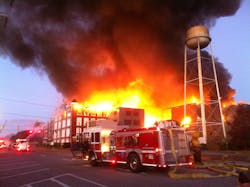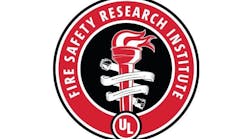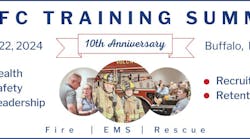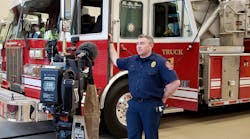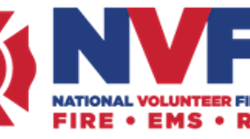On Saturday, Nov. 5, 2011, a three-alarm fire destroyed the historic Swift Textile Manufacturing Co. mill in downtown Columbus, GA. Despite challenges involving water supplies and unusual wind patterns, the fire was contained to building of origin and did not spread to any other business or adjacent property. Fire crews remained on the scene for two weeks as high winds caused smoldering roofing materials to dry out and flare up.
The original four-story mill was built in 1883 and several additions were made in different stages until 1968. A warehouse north of the mill was connected to the main mill by an overhead pedestrian bridge. Another warehouse was located to the northeast, across the railroad tracks. The facility operated as a textile mill from 1883 until it closed in 2006. At the time of the fire, the mill was in various stages of a demolition and remodeling project estimated to cost $50 million. When completed, the buildings were to include loft apartments, stores and office space.
The mill buildings consisted of various construction types, including brick, unreinforced masonry construction (URM) in Mill 2 and steel frame with URM infill. Construction features included load-bearing masonry walls with steel post beams and floors and the ceilings of exposed timber. The roof was constructed with exposed wood-truss roof structures and decking with metal and asphalt roofing.
Fire protection and detection systems were not intact or active and were in various stages of demolition. The interior private fire protection loop had been severely damaged from heavy equipment in the Charlie Division. All interior post indicator valves (PIVs) were in the shut position due to the demolition.
Defensive operations
The Columbus Department of Fire and EMS was dispatched to a reported structure fire at Swift Textile at 1410 6th Ave. at 6:04 P.M. Engines 1 and 6, Ladder 1, Squad 6 and Medic 1 responded with 16 firefighters under the command of Battalion 1. On arrival, heavy smoke was showing from the Charlie Division of Mill 2. Engine 1, Ladder 1 and Squad 6 were positioned on 6th Avenue, the Alpha side of Mill 2. Engine 6 was positioned on the Bravo side of Mill 2. Medic 1 set up the Medical Division north of the mill on 15th Street at 5th Avenue.
No interior operations were initiated due to the fact that the buildings were vacant and undergoing renovations. Engine 1 laid a 200-foot, five-inch line from a hydrant at 6th Avenue and 14th Street to a position near the Alpha/Delta corner of Mill 2 and placed its deck gun into operation. Ladder 1 laid a 200-foot, five-inch line from a hydrant on 6th Avenue between 14th and 15th streets to a position just north of Engine 1’s location on 6th Avenue. Ladder 1 was set up and placed its aerial master stream into operation. Engine 6 laid a 200-foot, five-inch supply line from a hydrant on 6th Avenue between 13th and 14th streets to a position south of Engine 1’s location. Firefighters stretched two 300-foot, three-inch lines to the Delta side of Mill 2 and placed a portable monitor into operation.
Additional resources
Command requested additional units from the Columbus Department of Fire and EMS at 6:10 P.M. Engines 2, 3, 8 and 10 and Ladders 6 and 8 responded with 23 firefighters along with Battalion Chief 2, Car 66 (a fire investigator) and Medic 6. Ladder 8 was positioned on 6th Avenue north of Ladder 1’s position and was supplied by a 200-foot, five-inch line from a hydrant at 6th Avenue and 15th Street. Ladder 6 was positioned on the Alpha/Delta corner of Mill 2, south of Ladder 1, and supplied by Engine 6 with two three-inch lines. Engine 8 was positioned at 7th Avenue and 15th Street, west of the structure and railyard (Charlie Division), and worked off the hydrant at that location using a five-inch line. A portable monitor was positioned across the railyard at the Charlie/Bravo side of Mill 2. The monitor was supplied by two 500-foot, three-inch lines. Engine 4 was assigned to the downtown area for fire watch.
Mutual aid
Command requested an additional aerial apparatus from Phenix City, AL, Fire Rescue at 7:30 P.M. Phenix City Platform 1 responded with four firefighters. This apparatus was positioned on 6th Avenue at the Alpha/Bravo corner of the building and supplied with a 100-foot, five-inch line from Columbus Engine 10, which was on the hydrant at 15th Street and 6th Avenue. Phenix City Platform 1 was strategically placed to protect the structure north of the fire building, which was connected by an elevated steel enclosed walkway in case other units failed to stop the spread of flames at a fire wall. Rehab was set up near the Medical Division on 5th Avenue at 15th Street. Phenix City Platform 1 was released at 10:16 P.M.
Command declared the fire under control at 11 P.M. Forty-six firefighters operated four engines, four aerial devices, one squad and two medic units along with logistical support units at the scene. Five hydrants on the municipal water system supplied 650,000 gallons of water to extinguish the fire. The fire scene was occupied by Columbus Fire and EMS for two weeks. The fire smoldered for weeks after the blaze as high winds continued in the area for days and the roofing material dried out and blazed up. Cadaver dogs worked the site after safety issues were addressed approximately three weeks after the incident.
An investigation into the origin and cause of the fire remains active by the Columbus Fire and EMS and the federal Bureau of Alcohol, Tobacco, Firearms and Explosives (ATF). Damage was estimated at $1 million to the building.
